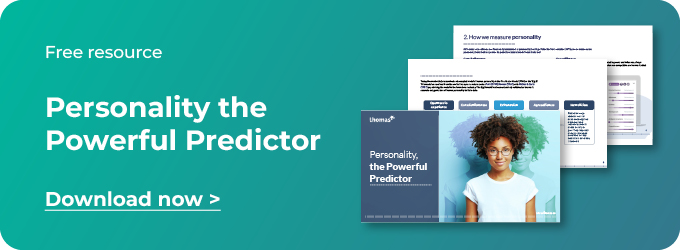When assessing an individual’s personality, the acronym OCEAN is widely used to describe the big 5 personality traits that help define said personality types. Openness, Conscientiousness, Extroversion, Agreeableness, and Neuroticism (OCEAN).
Today’s psychologists believe that these traits are the best way to measure personality and in doing so, give us insight into how someone will respond in situations, thus making it a powerful tool and predictor to success or failure within a job role. Because of this widely accepted theory and practice, recruiters and employers have started to use tools that measure these traits in order to understand a candidate’s OCEAN profile.
Openness, like all the other personality traits, works on a sliding scale; in principle, openness assesses how open-minded, imaginative, creative, and insightful a person is.
Today’s guide will specifically cover the openness trait. From how it can be measured, to how it can influence behavior in the workplace amongst other things.
What is openness?
Openness is how open-minded, imaginative, creative and insightful a person is or can be. More open minded people tend to prefer variety, seek new experiences and are curious and perceptive to their environment. Less open minded people tend to avoid change, dislike disruption and focus on a few specific interests.
This may sound like a colleague or two you are working with, or it could be that you are self-analyzing right now to better understand how open you are as a person. Like all traits, there is a sliding scale to openness and you may find yourself being more open in certain situations over others.
Thought of in another way, openness is about unshackling any preconceived ideas, enhancing your curiosity and going beyond your limits embracing change and new experiences. The level of openness which you experience shows how open minded you are and how prepared you are to accept change or something new in your life.
In fact, when we talk about openness, we are really describing openness to experience.
Openness to experience
Openness to experience is another way to describe openness but it is founded in the same principles as highlighted earlier. The more receptive you are to change, new experiences and being able to “think outside the box” is just a way of understanding this personality trait.
Think of your workplace or work environments where openness to experience is essential for sustained growth. These could be some of the more widely known Silicon Valley startups such as Google or TESLA. It could be your workplace where being able to experience new ideas and change is key to adapting with an ever-changing marketplace.
Not only does having a corporate culture which promotes and rewards this kind of attitude required, it’s about having the right people with an openness to experience that can also drive this attitude forward within the workplace.
It’s not uncommon to think that openness is more relevant for certain industries over others and there is a particular focus on more creative industries as you will find people with a higher openness to experience traits being in job roles that require creative thinking. Designers, artists, philosophers and even travelers prefer to challenge themselves and be challenged by new inputs and experiences.
However, a pilot for example also experiences a high openness trait and this is more relative to being able to problem solve and “think outside the box” which is a common sub-trait across the OCEAN profile.

Characteristics of openness
When looking at the characteristics of openness, there are six widely considered facets or subtraits of openness which make up this trait.
Imagination
There are lots of ways to coin this, but the most common term you can think of is “thinking outside the box”. Being able to let your imagination solve problems or challenges is just part of the conundrum.
Individuals who are open to exploring creative ideas within themselves and bring them to life are highly creative by nature. This level of imagination and using it to problem solve or create something new is a major characteristic of openness.
Those with low imagination prefer facts and logic over fantasy. Working on abstract ideas is less preferable to practical theories.
Artistic interests
Do you find yourself enjoying art of different kinds? Do you enjoy finding detail and perfection in everything you do? Well, if that’s the case you have artistic interests and you rely on imagination as well intuition in your day to day life.
Being interested by nature and highly artistic events also shows an independence in thought.
Emotionality
Finding emotional balance is what is meant by emotionality. There are two schools of thought about this area. The first is that we are conditioned by others in our young lives when it comes to expressing our thoughts and feelings - and the impact this has on emotionality.
The second is that being able to control balance is one that takes years of practice and meditation. Having high emotionality means that you have an awareness of your thoughts and feelings and can find composure in stressful situations.
Adventurousness
Widely regarded as one of the most important subtraits of openness. Taking chances, being daring and accepting whatever the outcome of the decision you’ve taken is a quality of adventurousness that is widely recognizable.
Someone high in this trait has a versatile approach to life and experiences excitement by doing something different and out of a normal routine - sometimes the more risky, the more the exhilarated one feels. Importantly, the more adventurous one is, the higher they will score in openness to experience tests because adventurous people lack the biggest restriction - fear.
Intellect
From problem solving to looking at abstract realities with curiosity and intrigue are signs of intellect that can be used in many different industries.
Those who score highly tend to be more philosophical and intelligent especially when it comes to unique concepts.
Liberalism
This is more to do with liberalism of choice over rules. Those with more liberal traits believe that dispersing power and nurturing uniqueness and diversity offers a solution for everyone.
High liberalism tendencies means that they think they are above the rules and score highly because they are willing to put forward their thoughts and express their opinions.
How openness influences behavior in the workplace
Openness to experience obviously does impact behavior in the workplace. When testing for this, employers and recruiters are trying to understand what level their teams have and how this will affect the workplace environment.
Of course being able to use openness to experience as a tool in recruitment and in re-aligning business goals is a powerful tool. So how can openness influence behavior in the workplace? Here are just some examples.
Imagination: Ability to explore new ideas and solutions
Does your team come across seemingly unsolvable problems? The more open your team, the more likely you will find solutions - sometimes in the less usual places.
Artistic interests: Creativity
Whether you work in a creative industry or something that could appear more logical in practice, having artistic interests can open the door to more independent thought within the workplace creating contrasting ideas that maybe wouldn’t be seen or considered.
Emotionality: Maintaining an emotional balance
Do you have a person or a team that can manage their emotions in adversity? Do you have volatility or emotional withholding, this is what you want to be able to assess.
Adventurousness: Ready to take risks
Will you have team members that want to take risks without consideration, or risk take after analysis. Can the business manage risk to a greater level or does it prefer stability.
Intellect: Intelligence and understanding
Having a team or a group of people that can think through choices being made and their consequences is a strength for a team. The higher the score, the more likely the individuals will enjoy solving very abstract problems.
Liberalism: Happy to express and share their views
Will you have team members that have no fear expressing their views? Will they disrupt by not following the rules or do you want to create disruption to enact change?
All of these elements can affect behavior in the workplace. One way of being able to see what level that disruption can take is by measuring openness.

How openness is measured
If you want to get a better understanding of individual openness then you need to be able to measure it. How is it done?
Openness is typically measured using self report questionnaires. Containing a number of statements, individuals choose the response that best reflects how much they agree or disagree with that statement.
Statements are designed to make you think about your responses and rate them from 1 (strongly disagree) to 5 (strongly agree). Examples of these statements include:
- I'm good at coming up with new ideas
- I often think about the deeper meaning of things
- I'm curious about how things work
- I enjoy thinking about theoretical ideas
- I have many artistic hobbies
- I have an active imagination
- I appreciate being around diverse groups of people
- I enjoy having philosophical discussions
- I like going to cultural events, art museums, and poetry readings
How Thomas assessments measure workplace personality
Of course, coming up with these questions yourself and then trying to understand how to mark them can be a nightmare, that’s why we have the perfect solution to measure workplace personality.
Our workplace personality test can be used to understand a candidate or employees level of openness, and wider personality by using the globally recognized and respected big 5 psychological theory. The High Potential Trait Indicator (HPTI) as it is also known, can also help to identify leadership potential.
Developed by Ian MacRae and Adrian Furnham in 2006, the HPTI has been designed based on an ‘optimality’ model, which assumes that personality traits can be considered ‘optimal’ based on the requirements of a particular job role or position, such as senior executive leadership.
Based as a self-report questionnaire, the answers which have 7 levels of agreement on a 1-7 Likert scale (1 ‘disagree completely’ to 7 ‘agree completely) with 78 unique items the test takes as little as 8 minutes to complete.
Whether you are looking for the next superstar to join your team, possibly even start to change team dynamics or you want to measure the level of openness in your workplace, the HPTI assessment can analyze all the data in one place giving you insight in minutes.
If you discover your team needs to develop a more open attitude, the HPTI assessment can show you what can be done to help as well as a deeper understanding of what will be difficult to change.
In summary
Openness is how open-minded, imaginative, creative and insightful a person is or can be. More open minded people tend to prefer variety, seek new experiences and are curious and perceptive to their environment.
From exploring new ideas to attaining more emotional balance, openness is measured on a sliding scale that can help businesses thrive in different circumstances.





